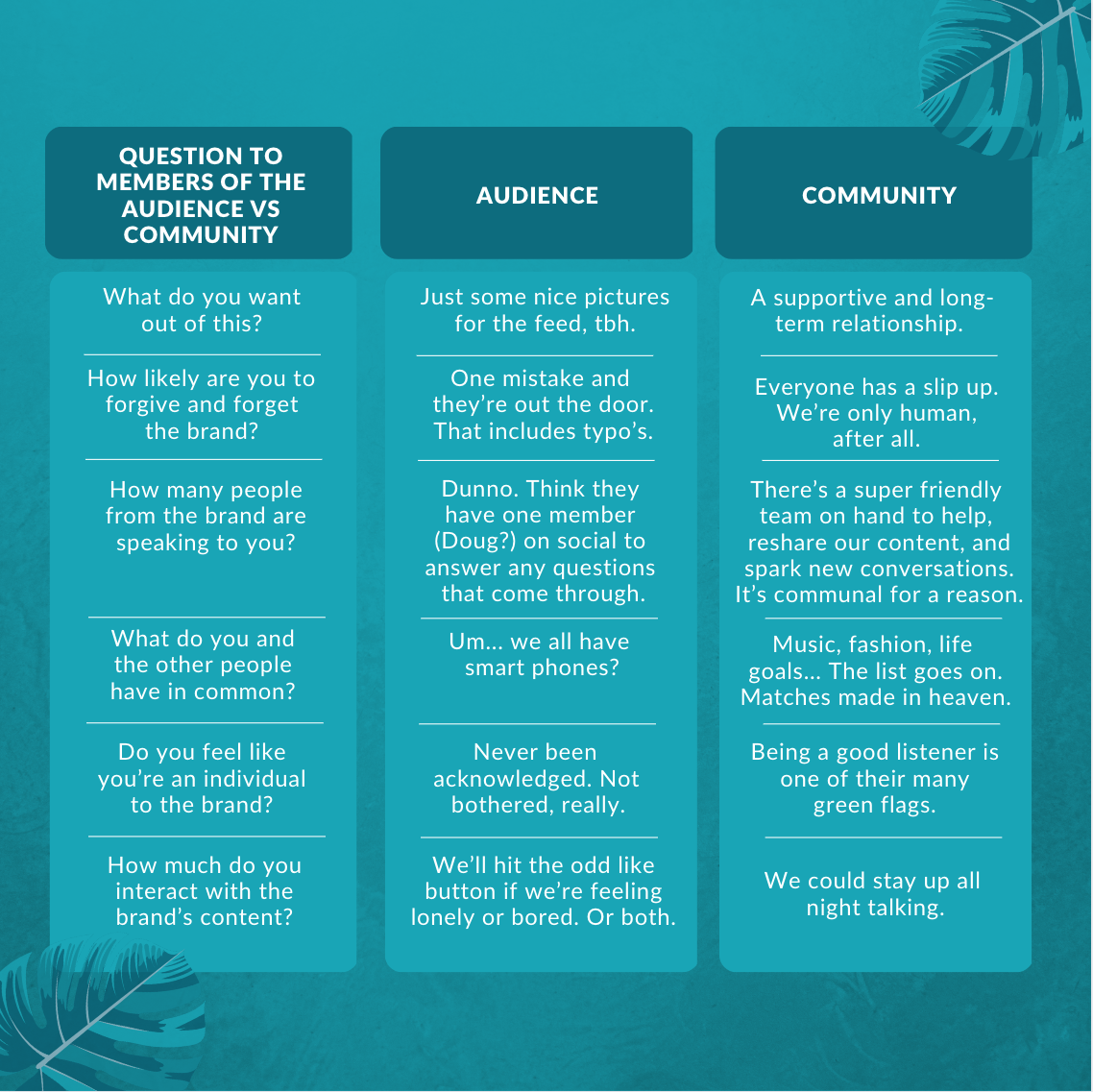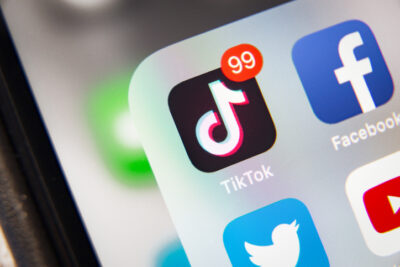Audience vs Community: Why It’s Time to Share the Consumer Love this Valentine’s Day
Flowers? Meh. Chocolates? Building a community with your audience? Now we’re talking. As Valentine’s Day approaches, we’re reflecting on how brands can share the love with their audiences by making them feel like the only customer in the world. Spoiler alert: it turns out offering a 10% discount code on all novelty mugs labelled with ‘his’ and ‘hers’ in a generic swirly font just isn’t going to cut it. *Shudders*
When it comes to fostering that loving community with your audience, you need to do more than just repost the odd Insta story with a cutesy gif. It’s 2023. People want to feel truly valued by the brands they invest in. They want to feel like they’re included in the development journey and nurtured in the way they interact with your team – as well as with the rest of the community.
In this blog, we’ll be covering:
- What is an audience?
- What is a community?
- What’s the difference between an audience and a community?
- The benefits of having a brand community
- Examples of successful community-driven brands
The great news is that social media and digital marketing have enabled us to connect with users in entirely new ways. People can feel ‘part’ of your brand simply by visiting your page and tapping that neatly enveloped direct message button – whether it’s to send a love letter of praise, or to ask why they’ve been ghosted by your customer service on Twitter. But there’s a catch. The more brands unlocking these benefits, the harder it is to cut through the noise and make your brand known as ‘the one’.
That’s why adopting a streamlined strategy that speaks volumes is key for optimum social media success. The first step? Understanding the difference between having a basic audience of followers and the value of building a community within which they can better engage with you.
Read ahead as we break it all down for you, along with some examples of brands that have marketing strategies that put even Cupid to shame…
(Alexa, play: Marvin Gaye, Let’s Get It On)
Audience vs Community – what does this mean?
It’s easy to assume that if you have a following of users on social platforms, you’re instantly the heart throb of all the people who consume your content. Are you having authentic conversations with them every day? How quick are you to respond to their messages? Do you feel they’d be willing to forgive and forget any mistakes you make?
If the answer to these questions is no, you may want to have a rethink about ways you can bring the spark back into your customer relationship. That way, you can nurture a more meaningful community to connect with them.
To help you understand what makes an audience and a community, here’s a quick rundown of the definitions…
What is an audience?
In social media terms, an audience refers to a large number of users that follow a brand’s page. While they may be faintly interested in the content, it’s unlikely that they will feel obliged to engage with it – whether through hitting that heart button or sliding into the DM’s. This goes beyond the screen, too. An audience of people aren’t going to be talking about the brand with their friends, or exchanging thoughts on what’s been shared, simply because they’re not passionate or excited enough about it. It’s passive – albeit pleasant – consumption.
What is a community?
A community is a space where the romance between your audiences can really develop. Think of it as a welcoming hub where like-minded users can connect over shared passions, hobbies, and life plans. It’s also where they can share experiences and things they have learned along the way. Despite not being together physically, they feel like they’re in the same room because of the level of relatability and trust. In many ways, a brand is there to act as the matchmaker – encouraging them to go from initial speed-dating introductions to virtual picnics in the park.
What’s the difference between an audience and a community?
Now you know the basics of what defines an audience and a community, you’re probably wondering what the difference is between them. Gaining a clear understanding of what sets them apart is key for creating a seamless strategy to help you and your audience become ‘one’.
Here’s a few of the main differences between an audience and a community:
- Unlike audiences, money can’t buy communities – Sure, you can buy 1,000 followers who match your target audience. But communities need to be nurtured and built up over time. You gotta work for them to earn their full support and respect.
- You talk to audiences, but in communities people talk to you – A good way to tell if you have an audience or a community is to see what the responses look like on your content. Are you simply putting posts out there with little engagement, or are people actively leaving comments, likes, and shares to express their thoughts?
- Audience is a one-to-many relationship, communities are many-to-many – You may have one person talking to a large audience on social media, making it tricky to maintain a relationship. But in a community, there tends to be a whole team of people on hand to connect with everyone within the group.
- People in an audience are passive, communities are fully engaged with your content – Whilst the odd ‘like’ might feel good for the social ego, it’s not going to do a whole lot in boosting your brand sentiment. People in communities feel supported by the brand they follow and see it as a safe space to interact with their content. In return, they’re supporting you.
- When it comes to mistakes, audiences tend to be far less forgiving than communities – Every brand is going to experience the odd tech glitch that stops a discount code from working or post a topical meme with a typo that kills the joke. Happens to the best of us. People in audiences can be brutal in this situation, whereas communities tend to be more forgiving.
- Audiences are impersonal, whereas communities feel more individual – People in an audience are more passive with a brand’s content, like an email newsletter they signed up for two years ago and still haven’t unsubscribed for, despite never opening it. Communities, however, feel they are treated more as an individual than just another social account.
Take another hazelnut truffle out of that Valentine’s selection box you bought for yourself and take a note of this handy comparison table.

What are the benefits of having a brand community?
- Develop products and services your audience actually want – When you have a strong community brand strategy, you can ask people what they’d like to see in any upcoming launches. Not only will this make customers feel included in your journey, but it will also mean you’re creating the best possible product to rival your competitors.
- Boost brand awareness and SEO value – The more consumers know about your brand and what you have to offer, the more people will search for you on Google. Plus, as people start to talk about you more via reviews or forums, your SEO score will indirectly increase. Effortless.
- Nurture a deeper connection with your audience – Never underestimate the power of having a more emotional relationship with your customers. Talking to audiences as individuals as opposed to another social media icon will enable you to build their trust and support – both of which are highly valuable for enabling business growth.
- Better customer service, better brand sentiment – Having a community driven strategy means you can reply to customer queries quickly, resolving any issues or preventing a crisis before it arises. Whilst complaints are unavoidable, managing them professionally and genuinely is a sure-fire way to increase your brand sentiment.
- Build and uphold a loyal customer base – As people in your community become invested in your brand, they’ll start to see you as the ‘go to’. The fact they can reach out to other people for reviews and advice makes their purchasing journey easier, as does the comfort of knowing what product or service they can expect.
- Enjoy the benefits of ‘word of mouth’ recommendations – Friend recommendations don’t come easy nowadays. With so much choice and access to countless reviews online, consumers are more selective about their purchases than ever before. Word of mouth, however? That’s a form of marketing you can’t put a price on. If you provide high-quality products and services – and have a strong community to prove it – people are more likely to recommend your brand to a friend.
Examples of successful community-driven brands
Beauty brand Glossier has become a ‘cult company’ over the last few years, and all for good reason. Its community grows by the day. From co-creating new products with their customers and using fans as ‘Glossier Reps’, to utilising the power of social along with the hashtag #GlossierGirl to encourage authentic UGC, Glossier has taken the world by storm… and its community is joining in on the journey. With a brand mission to ‘make the consumer feel seen’, this brand does more than just reshare consumer posts. They use them on their global ad campaigns for optimum exposure. Now that’s how it’s done (the fact that it saves on video production costs is a bonus).
Described as a brand that’s ‘built around belonging’, Air BnB has a community that enables hosts from all over the world to connect with each other. This helps them to feel truly part of the apartment rental service’s mission to provide unforgettable experiences for its travel-hungry customers, reinforcing its message that anyone can belong. This sense of togetherness runs through to the Air BnB social channels. What appears to be a constant stream of UGC is in fact incentive for millions of potential new customers keen to book their next trip. Pack your bags.
With over tens of thousands of global stores across the globe, Starbucks is a ‘cup half full’ brand keen to support its ever-growing community. By buying a morning latte stamped with the iconic logo from its baristas (also known as ‘partners’), you’re instantly united with the rest of its customers. By working closely with its suppliers and farmers, everything Starbucks does is about making people feel like they’re part of something so much bigger than a vente mocha. Plus, with loyalty programs and social initiatives available for members-only, those coffee connoisseurs sure know how to add extra shots to their marketing strategy.
Are you ready to fall in love with your marketing strategy?
Now you know everything there is to know about a brand community and why its worth investing in, you might be wondering how to make the first move with your customers. Thankfully, here at Lucre, we’re a team of passionate match makers. Get in touch with loveus@lucre.co.uk to amp up the chemistry and take your brand to new levels.




